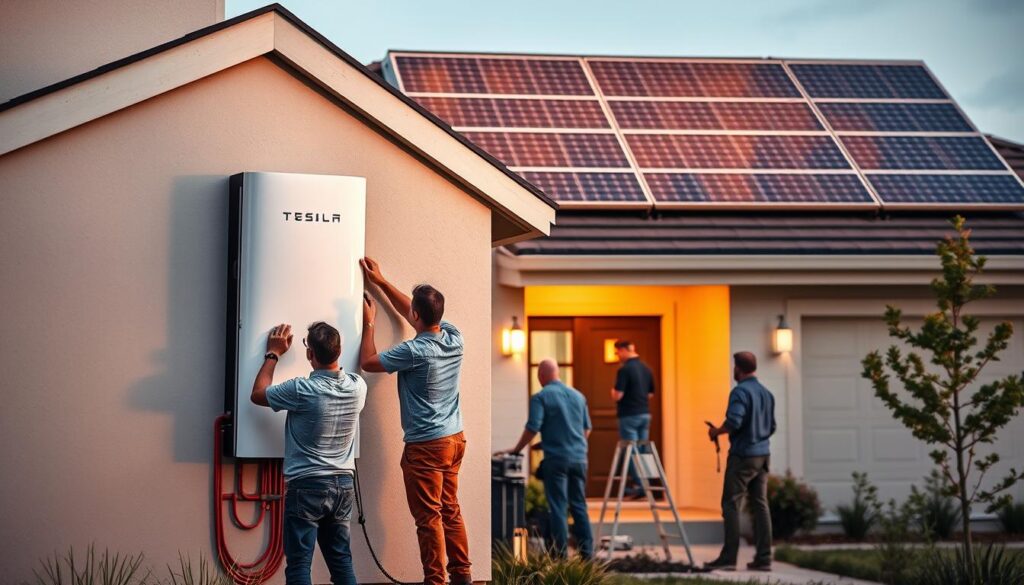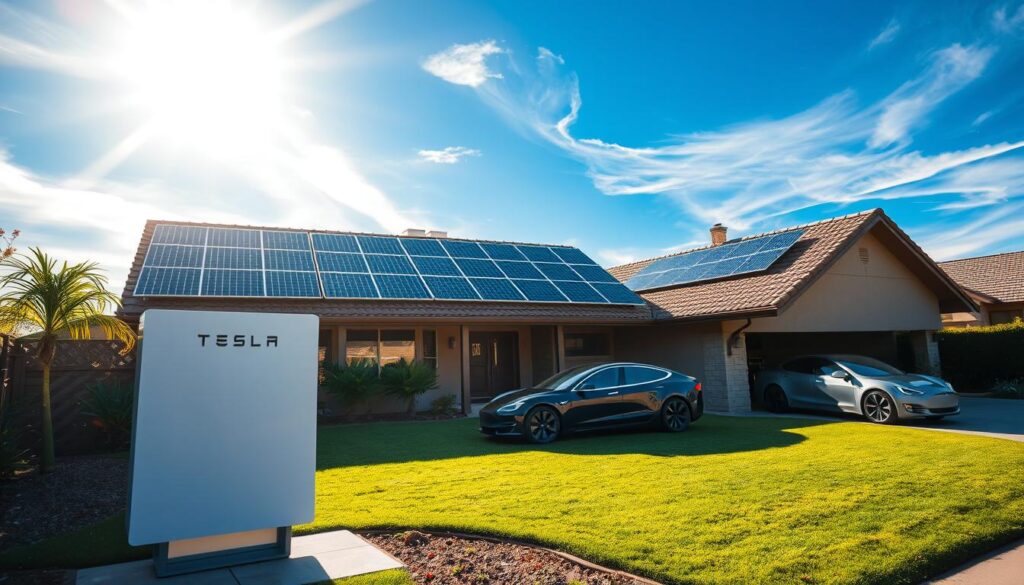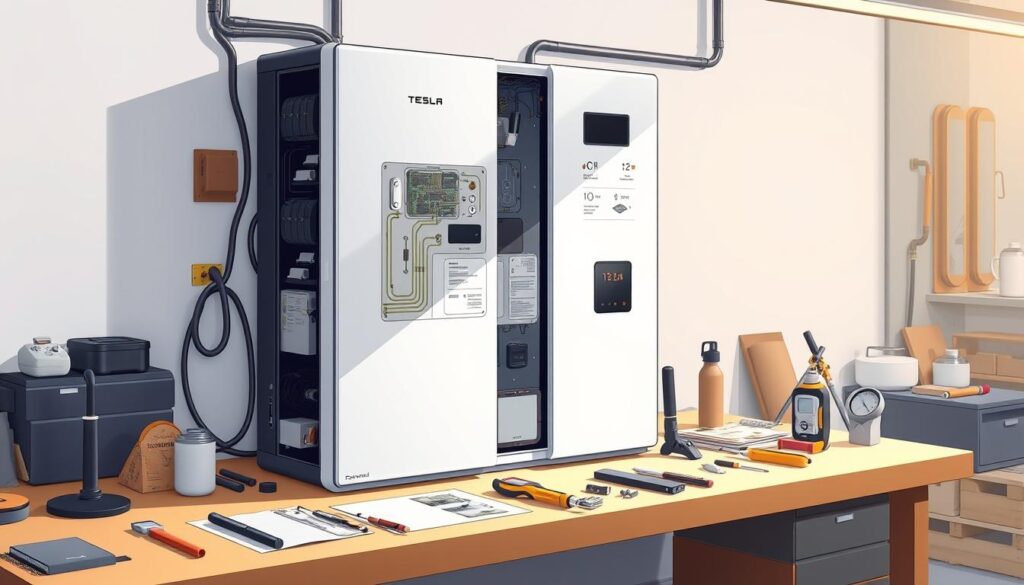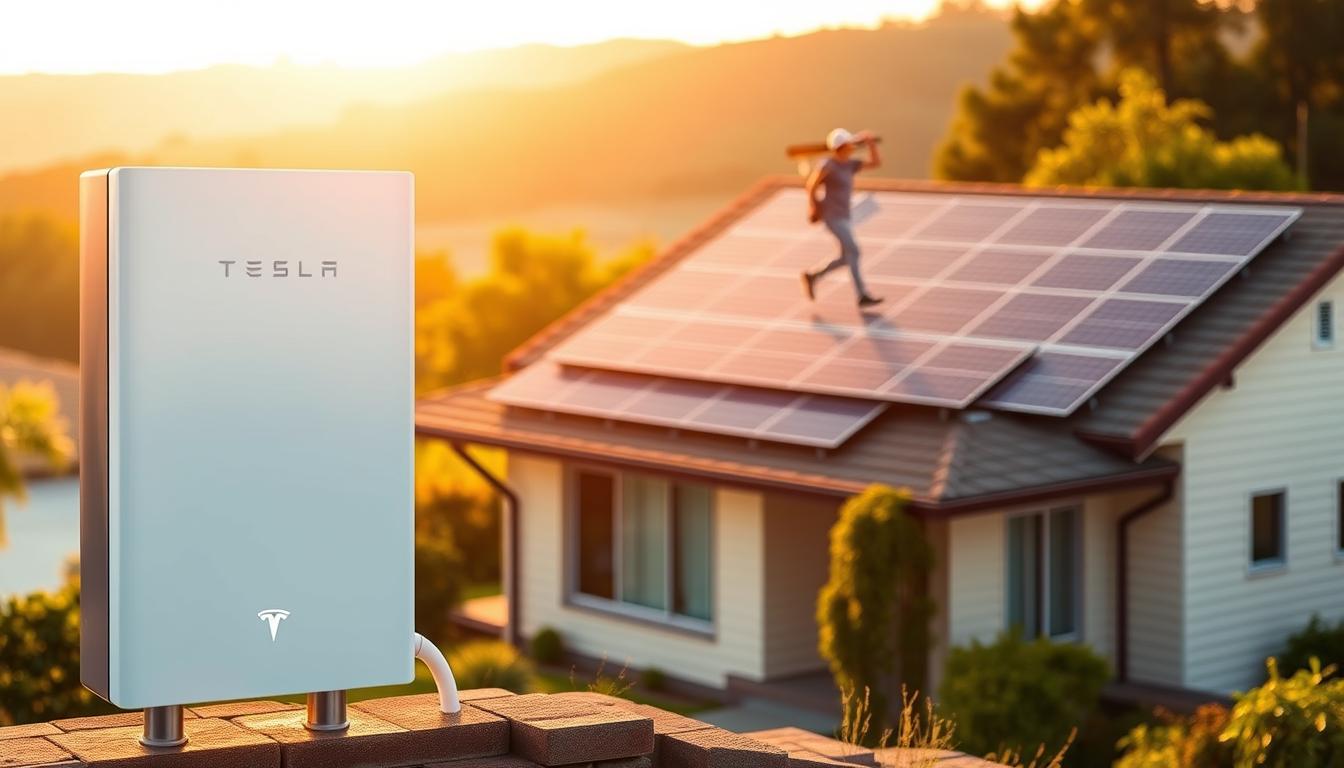More and more homeowners are choosing renewable energy solutions for their homes. Using solar panels with a energy storage system like the Tesla Powerwall is a smart move. It helps them gain energy independence.
This combo lets homeowners use the sun’s power, save extra energy, and have a solar battery backup when the power goes out. By pairing solar panels with the Tesla Powerwall, homes can use less grid power. This also cuts down on electricity bills.
Key Takeaways
- Combining solar panels with Tesla Powerwall for a complete home energy solution.
- Achieving energy independence with a reliable energy storage system.
- Having a solar battery backup during power outages.
- Reducing reliance on the grid and lowering electricity bills.
- Increasing the efficiency of renewable energy usage.
Understanding the Tesla Powerwall System
The Tesla Powerwall is changing how we store home energy. It uses new tech and looks great. It stores extra energy from solar panels or the grid, giving homes a steady power source.
What is the Tesla Powerwall?
The Tesla Powerwall is a rechargeable battery for homes and businesses. It keeps power on during outages, cuts energy costs, and boosts energy freedom.
Core Technology and Components
The Powerwall uses advanced lithium-ion cells for storing and using energy. It has an inverter that turns DC power into AC power, making it safe for homes.
Evolution of Powerwall Generations
Over time, Tesla has made the Powerwall better with each new version. The latest ones have more power, are more efficient, and charge faster.
How the Powerwall Works
The Powerwall stores extra energy from solar panels or the grid when it’s not needed. Then, it powers homes during busy times or when the power goes out. This cuts down on energy bills and reliance on the grid.
Current Powerwall Models and Specifications
Tesla has two main Powerwall models: the Powerwall 2 and the Powerwall+. Each has different energy storage and power outputs. Homeowners can pick the one that meets their energy needs.
The Power of Solar Integration
Tesla solar panels and Powerwall are changing how we view home energy. They let homeowners use solar energy now and save it for later. This move towards energy independence is significant.
How Tesla Solar Panels Complement the Powerwall
Tesla solar panels and Powerwall work together well. Solar panels make electricity during the day. This electricity is stored in the Powerwall for use at night or during outages. This setup ensures a steady energy supply for homeowners.
Tesla Solar Roof vs. Traditional Solar Panels
Homeowners often choose between Tesla Solar Roof and traditional solar panels. Each has its benefits, depending on efficiency, looks, and cost.
Efficiency Comparison
Tesla Solar Roof tiles are as efficient as regular solar panels. Tesla says they can reach up to 22.3% efficiency. Traditional panels might be a bit more efficient, sometimes over 23%. But, how much energy you get also depends on your roof’s size and angle.
| Product | Efficiency | Aesthetic Appeal |
|---|---|---|
| Tesla Solar Roof | Up to 22.3% | High |
| Traditional Solar Panels | Up to 23%+ | Variable |
Aesthetic Considerations
Tesla Solar Roof tiles are made to look good. They fit well with your roof and can match its color. This makes them a better choice for those who care about looks.
Energy Production and Storage Synergy
Together, Tesla solar panels and Powerwall make a strong team. They help you make clean energy, save it, and use less from the grid. This way, you get energy independence and lower your carbon footprint.
Benefits of Tesla Powerwall + Solar Panels
Using Tesla Powerwall with solar panels changes how we manage home energy. It gives a full and smart energy solution. This combo brings many advantages, making renewable energy a smart investment.
Energy Independence and Security
With Tesla Powerwall and solar panels, homeowners can make their own energy. This means they don’t have to rely on the grid as much. It’s very helpful in places where power outages happen often or the grid is not reliable.
Protection During Power Outages
When there’s no power, the Tesla Powerwall keeps the energy flowing. This is very important for homes that need power for medical equipment or other essential systems.
Reducing Carbon Footprint
Using solar energy and storing it for later helps cut down on carbon emissions. This green choice helps the planet and fights climate change.
Financial Savings Over Time
Putting Tesla Powerwall with solar panels saves money. Homeowners pay less for utilities and avoid high rates during peak times.
Utility Bill Reduction
Generating and storing your own energy means using less from the grid. This leads to lower bills.
Peak Rate Avoidance
The Tesla Powerwall stores extra energy made during off-peak hours. Then, it’s used when rates are high. This can save a lot of money over time.
In summary, Tesla Powerwall with solar panels is a great choice for those wanting energy freedom, safety, and savings. Knowing these benefits helps homeowners make better energy choices.
Assessing Your Home’s Energy Needs
To get the most out of Tesla Powerwall and solar panels, you need to know how much energy your home uses.
Calculating Your Daily Energy Consumption
Figuring out your daily energy use is key to picking the right Tesla Powerwall and solar panel size. Look at your utility bills to get an idea.
Using Utility Bills for Estimation
Your utility bills show how much energy you’ve used in the past. By studying these, you can spot trends and find your average daily energy use.
Accounting for Seasonal Variations
How much energy you use changes with the seasons. This is because your heating and cooling needs shift. Make sure your Tesla Powerwall and solar panels can handle these changes all year.
Determining Optimal Powerwall Capacity
Your Tesla Powerwall needs to hold enough energy for your solar panels to store during the day. This way, you can use it at night or when the power goes out.
Sizing Your Solar Panel System
The size of your solar panel system depends on a few things. These include how much energy you use, how much roof space you have, and your budget. A system that’s the right size lets you make the most of your energy production and storage.
| Energy Consumption | Recommended Solar Panel System Size | Suggested Powerwall Capacity |
|---|---|---|
| Low (less than 20 kWh/day) | 3-5 kW | 1 x Tesla Powerwall |
| Medium (20-40 kWh/day) | 5-7 kW | 2 x Tesla Powerwall |
| High (more than 40 kWh/day) | 7-10 kW or more | 3 or more Tesla Powerwall |
Site Evaluation for Tesla Energy Storage Installation
To get the best results, a detailed site evaluation is key for Tesla energy storage systems. This step is vital to check if the installation can work well and efficiently.
Solar Panel Placement Considerations
Where you place solar panels is very important for the Tesla system’s performance. You need to think about:
- Roof orientation and angle
- Shade analysis
- Structural integrity of the roof
Roof Orientation and Angle
The roof’s direction and slope greatly affect solar panel energy output. It’s best if panels face south to get the most energy.
Shade Analysis
It’s important to check for any shadows that could lower energy output. Tools like solmetric suneye help with this.
Powerwall Location Requirements
The Tesla Powerwall needs to be in a spot that’s easy to get to for upkeep. It should also be away from very hot or cold spots. It’s usually hung on a wall or on a strong base.
Electrical Panel Compatibility
It’s essential to make sure the electrical panel can work with the Tesla system. You might need to upgrade the panel for the new system.
A good site evaluation makes sure the Tesla system is set up right. This way, it works well, giving you reliable solar battery backup and more energy independence.
The Complete Installation Process

Getting a Tesla Powerwall and solar panels installed is a detailed process. It covers everything from permits to turning on the power. Each step is designed to make sure the system works well and safely.
Pre-Installation Preparations
Before we start, we prepare a lot. This includes getting the right permits and approvals from local authorities.
Permits and Approvals
Tesla helps homeowners get all needed permits. This makes sure the installation meets local building codes.
Scheduling with Tesla
After permits are sorted, Tesla picks a time for the installation. We choose a time that works for you, so it doesn’t disrupt your day.
Solar Panel Installation Steps
Installing solar panels requires several important steps.
Mounting Hardware Setup
First, we set up the mounting hardware on your roof. It’s designed to hold the solar panels securely.
Panel Placement and Wiring
Next, we place the solar panels on the hardware and connect them. This creates a complete solar array.
Powerwall Mounting and Connection
The Tesla Powerwall is installed in a safe spot. This could be your garage or utility room.
Backup Gateway Installation
We install a backup gateway. It manages energy flow between the solar panels, Powerwall, and the grid.
Battery Connection
Then, we connect the Powerwall to the solar array and electrical panel. This lets it store extra energy from the solar panels.
System Testing and Activation
After installation, we test the system. We check that it’s working right and safely.
Once it passes the test, we activate the Tesla energy system. You’ll have a reliable source of clean energy and backup power during outages.
Tesla Powerwall: Energy Storage and Solar Battery Backup Explained
For homeowners, understanding Tesla Powerwall is key. It’s a rechargeable battery that stores energy from solar panels or the grid. This makes sure you have power when the grid goes down or at night.
How Energy Storage Works During Different Times
The Tesla Powerwall works differently in the day and at night. It’s all about using and storing energy wisely.
Daytime Operation
In the day, it charges up with extra energy from your solar panels. This stored energy is ready for use at night or during outages.
Nighttime Operation
At night, it powers your home. This cuts down on your need for the grid and lowers your bills.
Backup Power Functionality
Tesla Powerwall keeps your home powered during grid outages. It ensures you always have energy.
Automatic Transfer During Outages
It automatically switches to battery power when the grid goes out. This keeps your energy supply steady.
Prioritizing Critical Loads
You can set it to give priority to important systems. This means your fridge or medical equipment gets power first during an outage.
Time-Based Control Features
Tesla Powerwall lets you control when it charges and discharges. This helps you save money by using off-peak rates and saving energy.
| Feature | Description | Benefit |
|---|---|---|
| Daytime Charging | Charges using solar energy | Reduces grid reliance |
| Nighttime Discharging | Powers home at night | Lowers energy bills |
| Backup Power | Provides power during outages | Ensures continuous energy supply |
Monitoring and Managing Your Tesla Energy System
To get the most out of your Tesla Powerwall and solar panels, you need to know how they work. The Tesla app is key in this, giving you tools to watch and manage your energy system.
Using the Tesla App
The Tesla app lets you see your energy use in real-time. It shows how your solar panels and Powerwall are doing at any moment. This is super helpful for keeping track of your energy.
Real-Time Energy Monitoring
With real-time monitoring, you can see how much energy your solar panels make and how much you use. This helps you use energy wisely.
System Control Features
The Tesla app also lets you control your energy settings. You can set when your Powerwall charges or uses energy. This helps you use energy better.
Understanding Energy Usage Patterns
Looking at your energy use through the Tesla app can show you when you use more energy. Knowing this lets you change your habits to use energy more efficiently.
Optimizing System Performance
To get the best from your Tesla system, check your energy data often. Changing your settings based on this data can help you use energy better.
| Feature | Description | Benefit |
|---|---|---|
| Real-Time Monitoring | Track energy production and consumption in real-time | Immediate insights into energy usage patterns |
| System Control | Adjust energy settings and control Powerwall charging/discharging | Optimized energy storage and usage |
| Energy Usage Analytics | Analyze historical energy usage data | Informed decisions about energy efficiency improvements |
Cost Analysis of Tesla Powerwall and Solar
It’s important to know the costs of Tesla Powerwall and solar panels for those thinking about renewable energy. This guide will help you decide on your energy future.
Initial Investment Breakdown
The cost of Tesla Powerwall and solar panels includes several parts. Knowing these costs helps figure out the total investment needed.
Equipment Costs
The price of Tesla Powerwall units and solar panels changes with model and capacity. For example, the Tesla Powerwall 2 is about $10,500 for a 13.5 kWh unit.
Installation Expenses
Installation costs vary from $2,000 to $5,000. This depends on the installation’s complexity and local labor rates.
Federal Tax Credits and Local Incentives
Homeowners can get help from federal tax credits and local incentives. The federal solar tax credit lets you deduct 26% of the total cost from your federal taxes.
Long-Term ROI Calculations
Calculating the return on investment (ROI) looks at energy savings over time. Here’s a simple ROI calculation table:
| Year | Energy Savings | Cumulative Savings |
|---|---|---|
| 1 | $500 | $500 |
| 2 | $550 | $1,050 |
| 3 | $605 | $1,655 |
Financing Options
There are many financing options for Tesla Powerwall and solar panels, including Tesla Financing and third-party options.
Tesla Financing
Tesla offers financing with competitive interest rates. This makes it easier to get their energy solutions.
Third-Party Options
Third-party financing companies offer different financing solutions. They have varying terms and conditions.
Understanding the costs and benefits helps you make a smart choice about Tesla Powerwall and solar panels.
Achieving Energy Independence with Tesla

Using Tesla means taking charge of your energy future. They offer advanced solar and storage solutions. As we move towards renewable energy, Tesla leads the way, giving homeowners the tools for energy self-sufficiency.
Reducing Reliance on the Grid
One key benefit of Tesla’s energy solutions is less reliance on the grid. With solar panels and the Tesla Powerwall, you can cut down on public utility use.
This not only ensures energy security but also protects you from high energy costs. Tesla’s energy solutions let you track your energy use in real-time. This makes it easier to use energy wisely.
Net Metering Benefits
Net metering is key to energy independence. It lets homeowners generate their own energy and send extra to the grid, lowering their bills.
How Net Metering Works
Net metering tracks the energy you produce versus what you use. If you make more, the extra goes to the grid, and you get credits on your bill.
State-by-State Policies
Net metering rules differ by state. Knowing your state’s policies is vital to get the most benefits. Tesla’s experts can guide you through these rules and optimize your system.
Steps Toward Complete Off-Grid Living
For full energy independence, Tesla offers a path to off-grid living. This means designing a system that meets all your energy needs without the grid.
This requires careful planning and a bigger initial investment. But, it offers long-term autonomy and big savings on bills. Tesla’s team helps homeowners plan and design a custom off-grid system.
Maintenance and Longevity
Keeping your Tesla Powerwall and solar panels in top shape is key. Regular checks and maintenance tasks are needed for optimal performance.
Solar Panel Maintenance Requirements
For your solar panels to work well, follow a maintenance routine. This includes:
- Regular cleaning to remove dirt and debris
- Performance monitoring to identify any issues early
Cleaning Procedures
Cleaning your solar panels is easy. Use a soft cloth or sponge with water to wipe away dirt. Stay away from harsh chemicals or abrasive materials that could harm the panels.
Performance Monitoring
Check your solar panels’ performance regularly with the Tesla app. This helps spot any energy production drops and fix problems quickly.
Powerwall Maintenance Schedule
The Tesla Powerwall needs little maintenance but should be checked often. Tesla suggests regular software updates to keep it running smoothly.
System Lifespan and Warranty Information
Tesla offers a solid warranty for both the Powerwall and solar panels. The Powerwall comes with a 10-year warranty. Solar panels are guaranteed for 25 years or more. Knowing your system’s lifespan and warranty gives you peace of mind and helps with future planning.
Troubleshooting Common Issues

When you use Tesla Powerwall and solar panels together, you might face some common problems. Knowing these issues can help keep your system running smoothly.
Solar Panel Performance Problems
Solar panel issues often stem from a few main causes. These include not producing enough energy and connection problems.
Production Shortfalls
If your solar panels aren’t making as much energy as they should, it could be due to a few reasons. Shading, dirt, or wear and tear on the panels are common culprits. Regular cleaning and checks can help fix these problems.
Connection Issues
Bad connections can really hurt your solar panel’s performance. Make sure all connections are tight and clean.
Powerwall Error Messages
Powerwall error messages can point to several issues. These might include communication problems or battery issues. Always check your Tesla manual for specific error codes and what to do next.
When to Contact Tesla Support
If you’re stuck on a problem or not sure how to fix it, it’s time to reach out to Tesla support. They can walk you through troubleshooting steps or arrange a service visit if needed.
| Issue | Possible Cause | Action |
|---|---|---|
| Low Energy Production | Shading, Dirt, Degradation | Clean Panels, Inspect for Damage |
| Connection Issues | Loose or Corroded Connections | Tighten and Clean Connections |
| Powerwall Error Messages | Various | Refer to Tesla Documentation, Contact Support |
Comparing Tesla to Alternative Energy Storage Solutions
Tesla Powerwall has changed the energy storage game. But how does it compare to others? Homeowners looking for energy freedom need to know the differences.
Tesla vs. LG Chem RESU
The LG Chem RESU is a big name in the market, rivaling Tesla Powerwall. It’s known for its high efficiency and sleek design. Yet, it’s often cheaper upfront.
Tesla vs. Enphase Encharge
Enphase Encharge stands out for its modular design, allowing for easy scaling. But, its setup can be complex. Tesla Powerwall, on the other hand, is known for its simplicity.
Tesla vs. Generac PWRcell
Generac PWRcell is a top choice for those who want reliable backup power. Tesla Powerwall also offers backup, but it shines when paired with solar panels.
Key Differentiators
Choosing the right energy storage solution depends on several factors. Performance and cost are key.
Performance Metrics
Efficiency and lifespan are vital. Tesla Powerwall has a 90% round-trip efficiency, matching its rivals. Most systems come with 10-year warranties.
Cost Comparison
The prices of Tesla Powerwall and its competitors vary. Tesla Powerwall might be pricier, but it integrates well with Tesla solar panels. This can lead to long-term savings, experts say.
In summary, Tesla Powerwall is a top choice, but other options like LG Chem RESU, Enphase Encharge, and Generac PWRcell have their own strengths. They might be better for certain homeowners.
Real-World Performance Case Studies
Homeowners who use Tesla Powerwall and solar panels have seen big benefits. They gain energy independence. Looking at real cases shows how well these systems work.
Suburban Home Implementation
A home in California got a Tesla Powerwall and solar panels. They figured out the home’s energy needs. Then, they set up the system to meet those needs.
System Configuration
The setup had 2 Tesla Powerwall units. They have a total of 26.2 kWh of energy storage. There were also 7.5 kW solar panels.
Energy Production Results
In a year, the solar panels made 10,237 kWh of electricity. The Powerwall stored extra energy. It’s used at night or during outages.
| Month | Energy Produced (kWh) | Energy Stored (kWh) |
|---|---|---|
| January | 842 | 210 |
| June | 1,023 | 305 |
| December | 701 | 180 |
Performance During Extended Power Outages
When a storm caused a power outage, the Tesla Powerwall kicked in. It kept essential appliances running.
Customer Satisfaction Reports
People using Tesla Powerwall and solar panels are very happy. They say it’s great for increased energy independence. They also save money on electricity bills.
Future of Home Energy Systems
The future of home energy systems is being shaped by Tesla’s cutting-edge technology and commitment to renewable energy. As the world moves towards sustainable energy, Tesla leads the way.
Tesla’s Roadmap for Energy Products
Tesla’s energy division is always improving. It focuses on making its energy storage products, like the Tesla Powerwall, more efficient and affordable. The company plans to advance battery technology and increase production.
Integration with Electric Vehicles
Tesla is working on linking its home energy systems with electric vehicles. This will bring new features like:
-
Vehicle-to-Home Power
-
Charging Optimization
This feature lets Tesla owners use their car’s battery to power their homes. It’s great for when there’s an outage or high demand.
Tesla’s tech optimizes charging electric vehicles with solar energy. This cuts down on grid use and lowers costs.
Smart Home Energy Management
Tesla’s home energy management system lets homeowners track and control energy use in real-time. They can do this through the Tesla app. It helps users save energy, cut waste, and get the most from their solar panels and energy storage system.
Conclusion: Powering Your Future with Tesla
Integrating Tesla Powerwall with solar panels offers a complete home energy solution. It promotes energy independence and a sustainable future. Homeowners can greatly reduce their grid reliance and have a reliable backup during outages.
The Tesla Powerwall system optimizes energy storage. This allows homeowners to use energy more efficiently and move towards off-grid living. Tesla’s technology lets homeowners track and manage their energy use in real-time, helping them achieve energy independence.
Investing in Tesla Powerwall and solar panels gives homeowners a clean, sustainable energy solution. It’s good for the environment and saves money in the long run. As the world shifts towards sustainable energy, Tesla leads the way. They empower homeowners to manage their energy needs.

